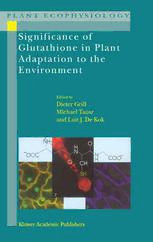
Significance of Glutathione to Plant Adaptation to the Environment PDF
Preview Significance of Glutathione to Plant Adaptation to the Environment
SIGNIFICANCE OF GLUTATHIONE TO PLANT ADAPTATION TO THE ENVIRONMENT Plant Ecophysiology Volume 2 Series Editors: Luit J. De Kok and Ineke Stulen University of Groningen, The Netherlands Aims & Scope: The Kluwer Handbook Series of Plant Ecophysiology comprises a series of books that deals with the impact of biotic and abiotic factors on plant functioning and physiological adaptation to the environment. The aim of the Plant Ecophysiology series is to review and integrate the present knowledge on the impact of the environment on plant functioning and adaptation at variouslevels of integration: from the molecular, biochemical, physiological to a whole plant level. This Handbook series is of interest to scientists who like to be informed of new developments and insights in plant ecophysiology, and can be used as advanced textbooks for biology students. The titles published in this series are listed at the end of this volume. Significance of Glutathione to Plant Adaptation to the Environment Edited by Dieter Grill University of Graz, Austria Michael Tausz University of Graz, Austria and Luit J. De Kok University of Groningen, The Netherlands KLUWER ACADEMIC PUBLISHERS NEW YORK, BOSTON, DORDRECHT, LONDON, MOSCOW eBookISBN: 0-306-47644-4 Print ISBN: 1-4020-0178-9 ©2002 Kluwer Academic Publishers NewYork, Boston, Dordrecht, London, Moscow Print ©2001 Kluwer Academic Publishers Dordrecht All rights reserved No part of this eBook maybe reproducedor transmitted inanyform or byanymeans,electronic, mechanical, recording, or otherwise, without written consent from the Publisher Created in the United States of America Visit Kluwer Online at: http://kluweronline.com and Kluwer's eBookstore at: http://ebooks.kluweronline.com v Dedicated to our friend, colleague and teacher Prof. Dr. Hermann Esterbauer who died too early Prof. Dr. Hermann Esterbauer, Institute of Biochemistry, University of Graz, Austria 1936 – 1997 vi We would like to thank Edith Hertl and Maria Grill for formatting and edit- ing of the manuscripts and Daniël J.A. De Kok for preparing the index, and John W. Anderson (Australia) Malcolm J. Hawkesford (U.K.) George Hendry (U.K.) Jonathan Howarth (U.K.) Graham Noctor (U.K.) Marinus L. Otte (Ireland) Nancy Grulke (U.S.A.) Nick Smirnoff (U.K.) for critical reading of the manuscripts. vii Contents Preface ix 1. Glutathione – An ancient metabolite with modern tasks Heinz Rennenberg 1 2. Chemistry of glutathione Willibald Wonisch and Rudolf-Jörg Schaur 13 3. The molecular biology and metabolism of glutathione Christine H. Foyer and Graham Noctor 27 4. The role of glutathione in the uptake and metabolism of sulfur and selenium John W. Anderson and Peter J. McMahon 57 5. The role of glutathione in plant response and adaptation to natural stress Michael Tausz 101 6. The role of glutathione in plant reaction and adaptation to ex- cess metals Wilfried E. Rauser 123 7. The role of glutathione and glutathione S-transferases in plant reaction and adaptation to xenobiotics Peter Schröder 155 8. The role of glutathione in plant reaction and adaptation to air pollutants Luit J. De Kok and Michael Tausz 185 9. The role of glutathione and glutathione-related enzymes in plant-pathogen interactions Gabor Gullner and Tamas Kömives 207 viii 10. Aspects of glutathione in the interaction between plants and animals Ewald Schnug and Christine Sator 241 Index 249 ix Preface The present volume of Plant Ecophysiology focuses on the biological significance of glutathione in plants. Glutathione or its homologues are pre- sent in nearly all living organisms and are directly or indirectly involved in many important metabolic reactions and in physiological functioning. The current ideas on the role of glutathione in plant metabolism and its signifi- cance in plant adaptation to biotic and abiotic stress is discussed in the dif- ferent chapters of the volume. Occasional overlaps of information between chapters could not be avoided; moreover, they reflect the central and multi- ple role of glutathione in integrated plant metabolism. The main aim of this volume is to raise the interest of advanced students and junior researchers in the role of glutathione in plants and to supply basic and comprehensive information for scientists already working on related topics. It must be emphasized that it was not the intention of the authors to present detailed scientific reviews about the various aspects of glutathione for specialists. Dieter Grill Michael Tausz Luit J. De Kok xi LIST OF CONTRIBUTORS JohnW.Anderson Department of Botany, School of Life Sciences, La Trobe University, Bun- doora, Victoria 3083, Australia e-mail: [email protected] LuitJ.DeKok Department of Plant Biology, University of Groningen, P.O. Box 14, 9750 AA Haren, The Netherlands e-mail: [email protected] ChristineH.Foyer Biochemistry and Physiology, IACR-Rothamsted, Harpenden, Herts, AL5 2JQ, United Kingdom e-mail: [email protected] Dieter Grill Institute of Plant Physiology, University of Graz, 51, A-8020 Graz, Austria e-mail: [email protected] Gabor Gullner Plant Protection Institute, Hungarian Academy of Sciences, H-1525 Buda- pest, P.O.B. 102, Hungary e-mail: [email protected] Tamas Kömives Plant Protection Institute, Hungarian Academy of Sciences, H-1525 Buda- pest, P.O.B. 102, Hungary e-mail: [email protected] PeterJ. McMahon Department of Botany, School of Life Sciences, La Trobe University, Bun- doora, Victoria 3083, Australia e-mail: [email protected] Graham Noctor Biochemistry and Physiology, lACR-Rothamsted, Harpenden, Herts, AL5 2JQ, United Kingdom e-mail: [email protected]
